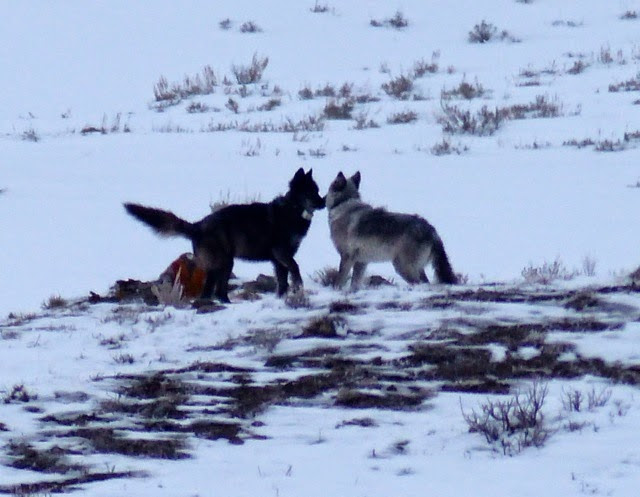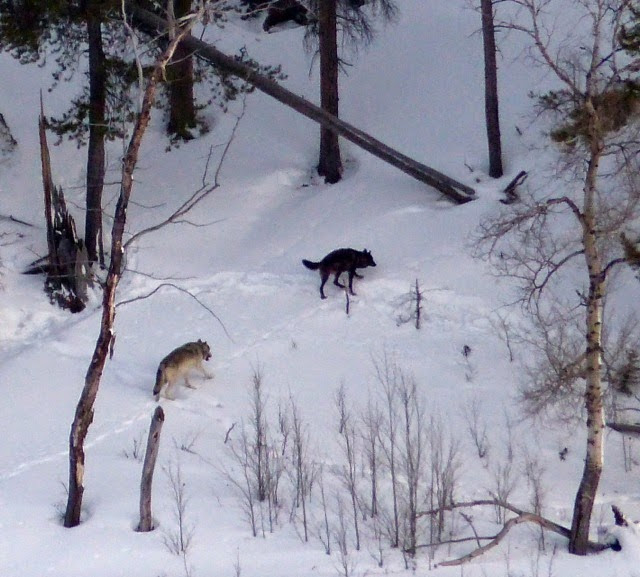
Wolf 755M (right) was the alpha male of the Lamar Canyon Pack seen here with 889F (left) the fourth wolf with whom he has tried to restart a pack after his mate was shot and killed outside Yellowstone Nat'l Park.
We met Rick Lamplugh and his wife on the 2013 Wolf Rendezvous. He has become a regular contributor to Oregon Wild and is the author of the new, bestselling book In the Temple of Wolves: A Winter's Immersion in Wild Yellowstone.
The results of legal wolf hunts are presented to the public as palatable statistics. Officials tell us, for example, that in the 2012-2013 hunts outside Yellowstone National Park twelve park wolves were killed. Six were collared wolves that--when alive--provided valuable research data. One of those collared wolves was the famous alpha female of the Lamar Canyon pack, dubbed "06" by wolf watchers.
Such statistics don't begin to tell the whole story of the impact of onebullet on the delicate social structure of a pack, an arrangement much like that of an extended human family. Here's what happened--and is still happening--to the remains of the once unified Lamar Canyon pack, wolves that my wife Mary and I observed many times during our first two winters living and volunteering at the Lamar Buffalo Ranch in the heart of their territory.
The wolf on the right in the photo above, called 755M for his research collar number, was the alpha male of the Lamar Canyon pack. That ended fifteen months ago when 06 was shot and killed. Her death left him outside the park with breeding season just around the corner. His drive to reproduce was strong, but he had a pack full of females that he would not mate with since they were his daughters. He left his family, returned to the Lamar Valley, and mated with an eligible female.
A few days later we heard that his daughters had returned to the valley. They attacked their father's new mate; she limped off to die in the woods. Early the next morning, we saw and heard the father as he howled and pleaded with his family members to join him. None did. 755M left the Lamar Valley alone. He eventually found two more mates but neither of those couplings led to the creation of a pack in which he could resume his alpha role.
The wolf on the left in the picture, called 889F, is the fourth wolf with which he has tried to start a pack. Wolf watchers believe she is pregnant. Even if the pups are born, the pack's chances of survival are not good.
Wolf experts have found that pack size matters. When 755M was the alpha male, the Lamar Canyon pack contained eleven wolves. Now he has only 889F, though a couple of other wolves sometimes travel with them.
Having only one other wolf--instead of ten--by your side presents life-threatening problems. Two wolves bring down less prey and eat less often than a larger pack. When a pair of wolves makes a kill, they lose more of it to ravens and other scavengers. Pups in smaller packs have less chance of surviving in general. Wolves in smaller packs are more likely to die from complications of mange. For reasons such as these, a smaller pack has less chance of staying together. 755M may find himself without a pack again--if he survives.
 That single hunter's bullet did more than kill the alpha female and uproot the alpha male. The lives of other pack members changed as well. The black wolf in the picture to the left is a daughter of 06. After her father left in search of a mate, the daughter paired up with this gray male that wolf watchers believe came from south of Cody, Wyoming. The pair returned to the Lamar Valley where they were collared. The black female is now called 926F; the gray male is 925M. Hidden inside the female may be developing pups, the hope that there will one day be another Lamar Canyon pack.
That single hunter's bullet did more than kill the alpha female and uproot the alpha male. The lives of other pack members changed as well. The black wolf in the picture to the left is a daughter of 06. After her father left in search of a mate, the daughter paired up with this gray male that wolf watchers believe came from south of Cody, Wyoming. The pair returned to the Lamar Valley where they were collared. The black female is now called 926F; the gray male is 925M. Hidden inside the female may be developing pups, the hope that there will one day be another Lamar Canyon pack.
Mary and I have often seen these two wolves in a territory that contains the den in which the female was born. Some wolf watchers believe that she has come home to give birth. If they have pups, and the pups survive until December of 2014, Yellowstone may once again have a Lamar Canyon pack.
I described above how having only one other adult wolf by your side presents life-threatening problems. A pair of wolves with pups--and no other pack members to help feed those pups--faces an additional threat: the mother must stay in the den to feed and care for the pups, so her mate must hunt by himself. A lone wolf will bring down less preyand lose even more of it to ravens and other scavengers. As a result, he will bring the nursing wolf less food. This could create nutrition problems for the mom or pups.
That single hunter's bullet shattered the entire Lamar Canyon pack. While the alpha male and one of his daughters have returned to the Lamar Valley, the rest of the pack has stayed outside the park and now lives in territory where they risk being hunted. Because they are outside the park, wolf watchers no longer observe the pack and little is known of their current number or condition. They are no longer called the Lamar Canyon pack.
I was saddened this winter--our third at the Lamar Buffalo Ranch--by the silence of the valley without the Lamar Canyon pack nearby. I can only hope that in a couple of years, a new pack may once again howl to the world that the valley is their home. If so, I hope they stay there and do not go out of the park where hunters wait.
Listing the results of wolf hunts as total or quotas ignores an essential truth: the death of a wolf--especially an alpha--throws the delicate social order of the pack into life-threatening disarray, forcing many wolves to choose new leaders, new roles, new lives.
 Rick Lamplugh is a regular contributor to Oregon Wild. He is the author of a new, bestselling book,In the Temple of Wolves, which is available on Amazon. Rick also accepts Friend requests on Facebook.
Rick Lamplugh is a regular contributor to Oregon Wild. He is the author of a new, bestselling book,In the Temple of Wolves, which is available on Amazon. Rick also accepts Friend requests on Facebook.
To order In the Temple of Wolves on Amazon:
http://amzn.to/1fsSYNN
Rick's Blog:
http://ricklamplugh.blogspot.com/
To Friend Rick on Facebook
https://www.facebook.com/rick.lamplugh
 '
'
